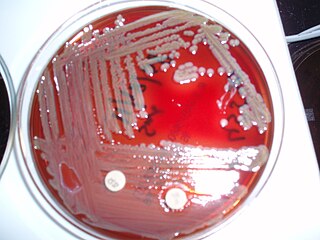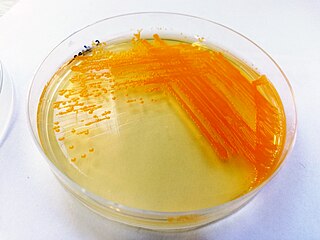
Marburg virus disease is a viral hemorrhagic fever in human and non-human primates caused by either of the two Marburgviruses: Marburg virus (MARV) and Ravn virus (RAVV). Its clinical symptoms are very similar to those of Ebola virus disease (EVD).

Melioidosis is an infectious disease caused by a gram-negative bacterium called Burkholderia pseudomallei. Most people exposed to B. pseudomallei experience no symptoms; however, those who do experience symptoms have signs and symptoms that range from mild, such as fever and skin changes, to severe with pneumonia, abscesses, and septic shock that could cause death. Approximately 10% of people with melioidosis develop symptoms that last longer than two months, termed "chronic melioidosis".

Elizabethkingia meningoseptica is a Gram-negative, rod-shaped bacterium widely distributed in nature. It may be normally present in fish and frogs; it may be isolated from chronic infectious states, as in the sputum of cystic fibrosis patients. In 1959, American bacteriologist Elizabeth O. King was studying unclassified bacteria associated with pediatric meningitis at the Centers for Disease Control and Prevention in Atlanta, when she isolated an organism that she named Flavobacterium meningosepticum. In 1994, it was reclassified in the genus Chryseobacterium and renamed Chryseobacterium meningosepticum(chryseos = "golden" in Greek, so Chryseobacterium means a golden/yellow rod similar to Flavobacterium). In 2005, a 16S rRNA phylogenetic tree of Chryseobacteria showed that C. meningosepticum along with C. miricola were close to each other but outside the tree of the rest of the Chryseobacteria and were then placed in a new genus Elizabethkingia named after the original discoverer of F. meningosepticum.

Chryseobacterium is a genus of Gram-negative bacteria. Chryseobacterium species are chemoorganotrophic, rod shape gram-negative bacteria. Chryseobacterium form typical yellow-orange color colonies due to flexirubin-type pigment. The genus contains more than 100 described species from diverse habitats, including freshwater sources, soil, marine fish, and human hosts.

Marburg virus (MARV) is a hemorrhagic fever virus of the Filoviridae family of viruses and a member of the species Marburg marburgvirus, genus Marburgvirus. It causes Marburg virus disease in primates, a form of viral hemorrhagic fever. The virus is considered to be extremely dangerous. The World Health Organization (WHO) rates it as a Risk Group 4 Pathogen. In the United States, the National Institute of Allergy and Infectious Diseases ranks it as a Category A Priority Pathogen and the Centers for Disease Control and Prevention lists it as a Category A Bioterrorism Agent. It is also listed as a biological agent for export control by the Australia Group.
Ravn virus is a close relative of Marburg virus (MARV). RAVV causes Marburg virus disease in humans and nonhuman primates, a form of viral hemorrhagic fever. RAVV is a Select agent, World Health Organization Risk Group 4 Pathogen, National Institutes of Health/National Institute of Allergy and Infectious Diseases Category A Priority Pathogen, Centers for Disease Control and Prevention Category A Bioterrorism Agent, and listed as a Biological Agent for Export Control by the Australia Group.
The phenotype microarray approach is a technology for high-throughput phenotyping of cells. A phenotype microarray system enables one to monitor simultaneously the phenotypic reaction of cells to environmental challenges or exogenous compounds in a high-throughput manner. The phenotypic reactions are recorded as either end-point measurements or respiration kinetics similar to growth curves.
Fannyhessea vaginae is a species of bacteria in the family Atopobiaceae. It is a facultative anaerobic, Gram-positive rod-shaped or elliptical coccobacillus found as single elements or in pairs or short chains. It is typically isolated from 80% of women with bacterial vaginosis and it is implicated in treatment failures. Invasive infections such as bacteremia have been reported.
Brucella intermedia is a bacterium from the genus of Brucella. It was first described by Velasco and others in 1998. It causes diseases in humans only rarely, with single case reports of cholangitis following liver transplantation, bacteremia in a patient with bladder cancer, a pelvic abscess after abdominal surgery, dyspepsia, endophthalmitis in the presence of a foreign body, pneumonia, and endocarditis.
Elizabethkingia is a genus of bacterium described in 2005, named after Elizabeth O. King, the discoverer of the type species. Before this genus being formed in 2005, many of the species of Elizabethkingia were classified in the Chryseobacterium genus. Elizabethkingia has been found in soil, rivers, and reservoirs worldwide.
Streptomyces zagrosensis is a bacterium species from the genus of Streptomyces which has been isolated from rhizospheric soil in the Fars Province in Iran.
Chryseobacterium daecheongense is a Gram-negative, non-spore-forming and non-motile bacteria from the genus Chryseobacterium which has been isolated from freshwater lake sediments.
Chryseobacterium hispalense is a Gram-negative and non-motile bacteria from the genus Chryseobacterium which has been isolated from a rainwater pond in Spain. Chryseobacterium hispalense can promote plant growth.

Chryseobacterium oleae is a bacterium from the genus Chryseobacterium which has been isolated from the rhizosphere of the olive tree Olea europaea in Seville in Spain. Chryseobacterium oleae can promote the plant growth.
Chryseobacterium gleum is a bacterium from the genus Chryseobacterium which has been isolated from a high vaginal swab from a human in London in England. Chryseobacterium gleum can cause infections in humans.
Cellulosimicrobium cellulans is a Gram-positive bacterium from the genus of Cellulosimicrobium. Cellulosimicrobium cellulans can cause rare opportunistic infections. The strain EB-8-4 of this species can be used for stereoselective allylic hydroxylation of D-limonene to (+)-trans-carveol.
Geodermatophilus amargosae is a Gram-positive and aerobic bacterium from the genus Geodermatophilus which has been isolated from desert soil from the Amargosa Desert in the United States.
Geodermatophilus normandii is a Gram-positive bacterium from the genus Geodermatophilus which has been isolated from desert sand from Ouré Cassoni in Chad.
Geodermatophilus saharensis is a Gram-positive and aerobic bacterium from the genus Geodermatophilus which has been isolated from desert sand from Ouré Cassoni in Chad.
Kocuria varians is a gram-positive species of bacteria in the genus Kocuria. It has been isolated from milk, meat, skin, soil, and beach sand. It is 0.9 to 1.5 micrometers in diameter, and occurs in clusters, which can be up to 4 millimeters in diameter and are yellow. It is known to cause ocular infections, brain abscesses, and endophthalmitis.



